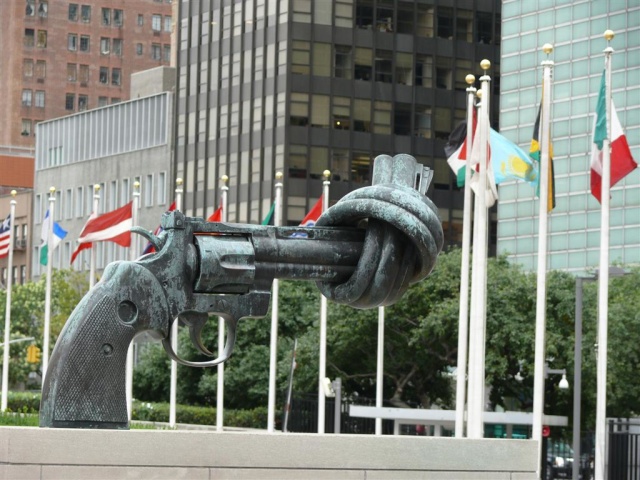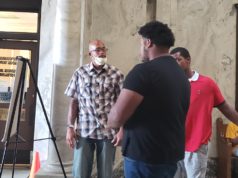A few nights after the Oct. 1 shooting at Umpqua Community College, James Kimmel, Jr., a lecturer in psychiatry at Yale, lay awake in bed wondering about crisis resources for people considering homicide.
He got up and searched the Internet, reasoning that, because suicidal individuals often seek help before acting, a person considering mass shootings might do the same.
“There wasn’t anything like that available,” he said. “I was shocked and not surprised at the same time.”
Less than a week later, on Oct. 9, Kimmel launched SavingCain.org, a website dedicated to “helping people understand and overcome the desire to kill others,” which Kimmel suggests is a “biological craving created inside the brain.”
On its opening page, Saving Cain uses the ages-old Biblical parable of Cain and Abel to explain the craving to kill, then provides resources to help someone overcome that urge and science-based research to understand it.
“We know finally there are two levers to drug control: supply and demand,” said Kimmel. “We spent decades in the war on drugs targeting supply, rather than demand, which is addressed with drug treatment. Gun control is a focus on the supply, but what about the demand?”
Examining the motivation to kill
Demand for gun violence might be addressed by what he calls “motive control,” or the second half of the conversation.
“Humans have done very little to circumvent using the weapon, whether in the form of a gun, or knife, or sharpened rock,” he said. “As a society, we ought to look at what the incentives and disincentives are for the motives of killing.”
According to the Neural Basis of Altruistic Punishment, a scientific study published in 2004, “the part of the human brain that processes rewards — such as the pleasure derived from desserts or narcotics — is also activated when humans inflict punishments upon wrongdoers.” In other words, justice-seeking is the same sort of biological craving experienced by drug addicts.
A line on Saving Cain’s opening page reads, “Unless you have a serious brain abnormality, what you are probably experiencing is a life-threatening, almost addiction-like compulsion to do harm.”
Kimmel believes if people can see their brain is creating the perception of being wronged and the desire to kill, “They can see that it can be uncreated.”
By using the archetypal story of Cain, Kimmel hopes to reach a potential killer (in five minutes) in ways that logical argument and research sometimes do not.
“Storytelling is powerful,” he said. “Someone can apply the story to their situation, then apply the current science to the story and see that he is dealing with a craving.”
On its resources page, the site recommends a person call the national suicide prevention lifeline (1-800-273-TALK) or visit Kimmel’s other site, nonjustice.org. In addition, it offers several books and online videos.
Pleading with site visitors to “SAVE LIVES (including your own),” Kimmel acknowledges the overwhelming desire to kill as an emergency that puts at least two lives at risk: the would-be killer and his target(s).
“It’s life-threatening in the truest sense,” Kimmel said.
A contagion effect
Donnie House, the 2-1-1 Helpline program manager in Tulsa, agrees that a homicidal situation is the same level of crisis as a suicide.
“Like suicide, someone is choosing a permanent solution to a temporary problem,” House said. “A crisis call is one that shows intent to cause harm or death. If we are convinced there is a high likelihood of an incident, it’s our responsibility to get an emergency response.”
Depending on the situation, that response could be dispatching their mobile outreach team, linking an individual with mental health professionals or calling 911.
Though this resource does exist, House says the “idea is new” to her.
“While it’s not advertised for this purpose, there is intervention that’s available before it escalates to the point of killing someone,” she said. “2-1-1- is a place to start.”
Kimmel envisions a future in which Americans are taught to reach out if they’re thinking of killing.
“We’re trained to call 911, poison control, and the suicide hotline. This is another piece of public education,” he said. “Imagine if we taught homicide and violence prevention like we teach drug prevention.”
In a recent New Yorker article, Malcolm Gladwell made the case that the type of men committing mass murder is becoming more and more heterogeneous, as if our national threshold is lowering, so that people whom you would not suspect capable of committing murder actually do.
“It’s a reasonable point,” said Kimmel. “Research suggests there is a contagion effect with these shootings — and if the research is right, then we better act quickly.”
Acting quickly, for Kimmel, meant getting the site up as fast as possible.
“These things are happening at an increasing pace,” he said. “Every day comes and you wonder if you’ll see the next report.”
Now that SavingCain.org is live, he hopes to expand the national conversation to include motive control and homicide prevention.
House agrees with the idea.
“We need to have public awareness similar to suicide awareness that intervention is available,” she said.

















